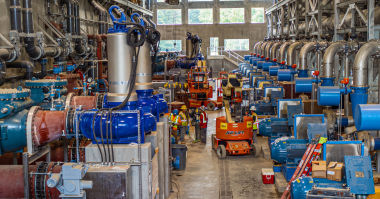This question is surprisingly common. Most people think of pipelines as running horizontally, but many GIW Industries, Inc. customers who pump ore need to move their material from the ground floor up three or four stories to a cyclone or other process operation.
Vertical transport of solids is easier than you might think. In fact, vertical pipes are a much better choice than inclined pipes. Solids in vertical pipes tend to move toward the center of the pipe, so there isn’t a bed of solids increasing friction loss as there is in a horizontal pipe. And as long as you maintain sufficient velocity in the upward moving flow, solids will move freely. Velocity is the critical factor in vertical transport. The upward velocity of the particles must exceed the fall velocity. A good rule of thumb is to make sure the upward velocity is three to four times the particle fall velocity.
You can calculate this ratio or determine it with a simple experiment. Methods of calculating fall velocity are easy to find and are covered in the GIW textbook, Slurry Transport Using Centrifugal Pumps.
Problems in vertical pipelines occur when one of two things happen:
- The upward velocity slows
- An emergency shutdown stops the flow entirely
As the GIW Vertical Pipe video shows, when the velocity in the upward leg of the pipeline slows, solids begin to build up inside the pipe. They will eventually create a blockage. If the flow is suddenly stopped, as in the case of an unexpected shutdown, all those particles will remain stuck in the upward leg of the pipeline, fall into the bottom elbow of the line, or even block the pump itself.
Unfortunately, in a working pipeline, you can’t see those blockages. But if you try to restart a line with a blocked pipe or a blocked pump, you could end up with massive damage, including a broken pump shaft or catastrophic damage to other parts.
The best procedure for shutting down a vertical pipeline is to pump clear water for approximately 20 minutes — or long enough to eliminate all slurry particles — before shutdown.
In the case of an emergency shutdown, it’s critical to be aware that those blockages will exist. Plan to dismantle your pipeline and pump to remove the debris before restarting.



